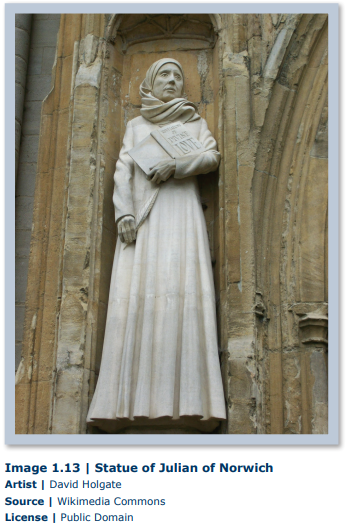1.22: Julian of Norwich
- Page ID
- 8753
(ca. 1342-ca. 1416)
Julian of Norwich was an English mystic and anchoress who had a series of visions during a serious illness, which were recorded as the Revelations of Divine Love. Anchorites took a vow to withdraw from the world, usually by staying in a small room—or “cell”—that was attached to a church. Anchorites could be monks or nuns, or they could be laypeople who had decided to devote the rest of their lives to religious contemplation. Julian may have taken her name from St. Julian’s Church, in Norwich, to which her cell was attached. Despite the isolation, anchorites were expected to act as advisors to those seeking religious guidance, since their activities gave them a certain status. Margery Kempe, who wrote a book on her own religious visions, records visiting Julian to ask her advice. Julian’s sixteen visions occurred when she was, by her own account, thirty-and-ahalf years old, in May of 1373, during a near-death experience. The shorter version, or Short Text, was probably written soon afterwards, and the Long Text appears to have been written about twenty years later, after she had contemplated the visions in depth. The revelations focus not only on Christ’s suffering, which was a common approach in her time, but also on God’s love in an optimistic way. According to the visions, sin is “behovely”—inevitable, necessary, or appropriate—since it leads to self-knowledge, which in turn leads the sinner to God. Perhaps the most famous section of the Revelations is when God is revealed as the mother, as well as the father, of humanity, with an emphasis on the actions that a mother takes to influence her child’s behavior. Julian’s text influenced later authors, such as T.S. Eliot, who quotes both the description of sin and her most famous lines in his poem “Little Gidding:” “Sin is behovely, but all shall be well, and all shall be well, and all manner of thing shall be well” (Eliot).

1.15.1 Bibliography
Eliot, T.S. “Little Gidding.” Four Quartets. New York, Harcourt, 1943.


